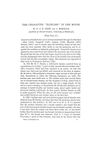TLDR The hairless gene mutation causes baldness by disrupting hair follicle structure.
The study investigated the pathogenesis of the hairless phenotype in HRS/J hairless mice, focusing on the mutation of the hairless (hr) gene. This mutation caused abnormalities during the first hair follicle regression (catagen), leading to complete baldness. The research revealed that in hr skin, only two epithelial cell populations in the distal outer root sheath (ORS) retained integrity, while the rest disintegrated. The surviving distal ORS formed utriculi, and remnants of the bulge retained the ability to proliferate, producing epithelial outgrowths or dermal cysts. The study suggested that the hr mutation disrupted key functional tissue units in hair follicles, possibly due to dysregulated apoptosis or impaired cell adhesion, while the distal follicle epithelium remained largely unaffected. The findings provided insights into the molecular and cellular consequences of the hr gene mutation, offering a model for understanding hair follicle integrity during catagen.
45 citations
,
March 1997 in “Journal of Investigative Dermatology” 70 citations
,
March 1997 in “Journal of Investigative Dermatology” 67 citations
,
February 1994 in “Developmental dynamics” Specific proteins and molecules play key roles in the development of human hair follicles.
36 citations
,
January 1994 in “Cell and Tissue Research” 45 citations
,
December 1991 in “Annals of the New York Academy of Sciences” Adhesion molecules are crucial for the development of feathers and hair.
59 citations
,
August 1981 in “PubMed” Trichilemmal keratinization is a unique process in hair follicles where the outer root sheath turns into keratin without a specific layer.
40 citations
,
February 1946 in “Canadian Journal of Research/Canadian journal of research” Hereditary factors cause hair loss in mice by affecting skin and hair follicle structure.
 35 citations
,
November 1931 in “Journal of Genetics”
35 citations
,
November 1931 in “Journal of Genetics” Hairless mice lack fur due to a genetic mutation affecting skin response, not hormone issues.
17 citations
,
March 2012 in “Journal of biological chemistry/The Journal of biological chemistry” Hairless protein affects hair follicle structure by regulating the Dlx3 gene.
 94 citations
,
February 1994 in “The journal of investigative dermatology/Journal of investigative dermatology”
94 citations
,
February 1994 in “The journal of investigative dermatology/Journal of investigative dermatology” EGF makes hair follicles grow longer but stops hair production.

